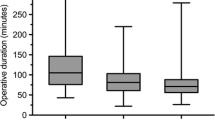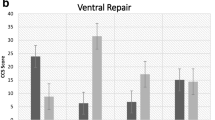Abstract
Little is known about how robot technology is employed by surgeons in minimally invasive surgery (MIS). We evaluated the needs of established robotic surgeons and of those who are new to this technology. A survey was designed and sent electronically to MIS surgeons. Questions included fellowship training, area of expertise, experience with robotic simulation and in clinical use, mentorship, likelihood of switching to a different approach, and expectations for the robot. Descriptive analysis was conducted using STATA/MP 15.1. 189 interviewees self-identified as hernia surgeons. 73.8% had additional fellowship, with majority practicing for 3–6 years (54%). Nearly 40% were MIS surgeons (N = 73), followed by general surgery (34.4%), and bariatrics (13.8%). 146 interviewees (77.7%) have used the daVinci® in clinical scenarios. Among robotic surgeons, majority were performing less than ten robotic cases per month. Inguinal hernia repairs were the leading procedures (49%), followed by foregut-related (19.5%), and colorectal-related surgeries (17.5%). Nearly 40% of surgeons stated inguinal hernia repairs to be the most often performed procedure using the robot. Nearly 40% of open and laparoscopic hernia surgeons are willing to adopt robotic-assisted procedures for their inguinal hernia repairs. Level 1 evidence (47.9%) and cost (24.1%) were the most pressing needs for robotic research. Majority of interviewees have used the daVinci® in clinical settings. Hernia repair remains the primary application of the robot in general surgery, among specialized surgeons. Over 40% of hernia surgeons are interested in switching to robotic technology over its open or laparoscopic counterparts.
Similar content being viewed by others
References
Armijo PR, Pagkratis S, Boilesen E, Tanner T, Oleynikov D (2018) Growth in robotic-assisted procedures is from conversion of laparoscopic procedures and not from open surgeons' conversion: a study of trends and costs. Surg Endosc 32(4):2106–2113
Kelley WE Jr (1990s) The evolution of laparoscopy and the revolution in surgery in the decade of the 1990s. JSLS 12(4):351–357
Tsui C, Klein R, Garabrant M (2013) Minimally invasive surgery: national trends in adoption and future directions for hospital strategy. Surg Endosc 27(7):2253–2257
Kevric J, Papa N, Toshniwal S, Perera M (2018) Fifteen-year groin hernia trends in australia: the era of minimally invasive surgeons. ANZ J Surg 88(4):E298–E302
Marcus HJ, Hughes-Hallett A, Payne CJ et al (2017) Trends in the diffusion of robotic surgery: a retrospective observational study. Int J Med Robot. https://doi.org/10.1002/rcs.1870(Epub 2017 Nov 6)
Zendejas B, Ramirez T, Jones T et al (2012) Trends in the utilization of inguinal hernia repair techniques: a population-based study. Am J Surg 203(3):313–317 (discussion 317)
Miller DC, Wei JT, Dunn RL, Hollenbeck BK (2006) Trends in the diffusion of laparoscopic nephrectomy. JAMA 295(21):2480–2482
Camarillo DB, Krummel TM, Salisbury JK Jr (2004) Robotic technology in surgery: past, present, and future. Am J Surg 188(4A Suppl):2S–15S
Casarin J, Multinu F, Ubl DS et al (2018) Adoption of minimally invasive surgery and decrease in surgical morbidity for endometrial cancer treatment in the united states. Obstet Gynecol 131(2):304–311
Benmessaoud C, Kharrazi H, MacDorman KF (2011) Facilitators and barriers to adopting robotic-assisted surgery: contextualizing the unified theory of acceptance and use of technology. PLoS ONE 6(1):e16395
Peters BS, Armijo PR, Krause C, Choudhury SA, Oleynikov D (2018) Review of emerging surgical robotic technology. Surg Endosc 32(4):1636–1655
Gamagami R, Dickens E, Gonzalez A et al (2018) Open versus robotic-assisted transabdominal preperitoneal (R-TAPP) inguinal hernia repair: a multicenter matched analysis of clinical outcomes. Hernia 22(5):827–836
Stefanidis D, Wang F, Korndorffer JR Jr, Dunne JB, Scott DJ (2010) Robotic assistance improves intracorporeal suturing performance and safety in the operating room while decreasing operator workload. Surg Endosc 24(2):377–382
Newman RM, Umer A, Bozzuto BJ, Dilungo JL, Ellner S (2016) Surgical value of elective minimally invasive gallbladder removal: a cost analysis of traditional 4-port vs single-incision and robotically assisted cholecystectomy. J Am Coll Surg 222(3):303–308
Higgins RM, Frelich MJ, Bosler ME, Gould JC (2017) Cost analysis of robotic versus laparoscopic general surgery procedures. Surg Endosc 31(1):185–192
Chen R, Rodrigues Armijo P, Krause C, SAGES Robotic Task Force, Siu KC, Oleynikov D (2019) A comprehensive review of robotic surgery curriculum and training for residents, fellows, and postgraduate surgical education. Surg Endosc 34:361–367
Ayloo S, Roh Y, Choudhury N (2014) Robotic cholecystectomy: training of residents in use of the robotic platform. Int J Med Robot 10(1):88–92
Nelson EC, Gottlieb AH, Muller HG, Smith W, Ali MR, Vidovszky TJ (2014) Robotic cholecystectomy and resident education: the UC davis experience. Int J Med Robot 10(2):218–222
Acknowledgements
The address for Dr. Dmitry Oleynikov and Dr. Salim Hosein reflect their address at the time the study was performed.
Author information
Authors and Affiliations
Corresponding author
Ethics declarations
Conflict of interest
Dmitry Oleynikov is stockholder of Virtual Incision Corporation. Priscila Rodrigues Armijo, Bhavani Pokala, Laura Flores, and Salim Hosein declare that they have no conflict of interest.
Statement of human rights
This study had an exempt protocol approved by the Institutional Review Board at our Institutition. All procedures followed were in accordance with the ethical standards of the responsible committee on human experimentation (institutional and national) and with the Helsinki Declaration of 1975, as revised in 2000.
Informed consent
This type of study was not classified as human subject’s research; therefore, formal consent was not required.
Additional information
Publisher's Note
Springer Nature remains neutral with regard to jurisdictional claims in published maps and institutional affiliations.
Rights and permissions
About this article
Cite this article
Armijo, P.R., Pokala, B., Flores, L. et al. Current state of robotic use in inguinal hernia repair: a survey of minimally invasive hernia surgeons. Updates Surg 72, 179–184 (2020). https://doi.org/10.1007/s13304-020-00709-6
Received:
Accepted:
Published:
Issue Date:
DOI: https://doi.org/10.1007/s13304-020-00709-6




